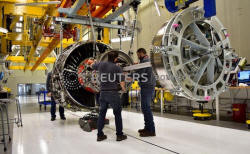U.S. fourth-quarter GDP revised down; profits weak
 Send a link to a friend
Send a link to a friend
 [March 28, 2019]
WASHINGTON, (Reuters) - - The U.S. economy
slowed more than initially thought in the fourth quarter, keeping growth
in 2018 below the Trump administration's 3 percent annual target, and
corporate profits failed to rise for the first time in more than two
years. [March 28, 2019]
WASHINGTON, (Reuters) - - The U.S. economy
slowed more than initially thought in the fourth quarter, keeping growth
in 2018 below the Trump administration's 3 percent annual target, and
corporate profits failed to rise for the first time in more than two
years.
Gross domestic product increased at a 2.2 percent annualized rate, the
Commerce Department said on Thursday in its third reading of
fourth-quarter GDP growth. That was down from the 2.6 percent pace
estimated in February.
The economy grew at a 3.4 percent pace in the third quarter. The
expansion will be the longest on record in July.
The revisions to the fourth-quarter GDP reading reflected markdowns to
consumer and business spending, as well as government outlays and
investment in homebuilding.

For all of 2018, the economy grew 2.9 percent as previously reported,
despite the White House's fiscal stimulus of $1.5 trillion in tax cuts
and more government spending. Growth last year was the strongest since
2015 and was an acceleration from the 2.2 percent logged in 2017.
Compared to the fourth quarter of 2017, the economy expanded 3.0
percent, revised down from the 3.1 percent reported last month.
President Donald Trump has highlighted the year-on-year growth figure as
proof that fiscal stimulus, which has contributed to a swelling of the
federal government deficit, has put the economy on a sustainable path of
strong growth.
Trump likes to showcase the economy as one of the biggest achievements
of his term, declaring last July that his administration had
"accomplished an economic turnaround of historic proportions." On the
campaign trail, Trump boasted he could boost annual GDP growth to 4
percent, a goal analysts always said was unrealistic given low
productivity, among other factors.
Economists polled by Reuters had forecast GDP in the fourth quarter
being revised down to a 2.4 percent.
There are signs the slowdown in growth persisted early in the first
quarter, with retail sales rising modestly and manufacturing production
and homebuilding tepid.
That was underscored by weak profits in the fourth quarter. After tax
corporate profits were unchanged for the first time since the third
quarter of 2016, after growing at a 3.5 percent rate in the third
quarter. A profit measure that corresponds to S&P 500 profits fell $34.2
billion in the fourth quarter.
[to top of second column] |

Technicians build LEAP engines for jetliners at a new, highly
automated General Electric (GE) factory in Lafayette, Indiana, U.S.
on March 29, 2017. REUTERS/Alwyn Scott/File Photo

The economy is facing headwinds from the fading stimulus, slowing global growth,
Washington's trade war with China and uncertainty over Britain's departure from
the European Union.
These contributed to the Federal Reserve's decision last week to bring its
three-year campaign to tighten monetary policy to an abrupt end. The U.S.
central bank abandoned projections for any interest rate hikes this year after
increasing borrowing costs four times in 2018.
Growth in consumer spending, which accounts for more than two-thirds of U.S.
economic activity, increased at a 2.5 percent rate in the fourth quarter instead
of the previously reported 2.8 percent pace. Consumer spending remains
underpinned by a strong labor market.
Growth in business spending on equipment was revised down to a 6.6 percent pace
from a 6.7 percent rate. Investment in intellectual products was lowered to a
10.7 percent rate from the 13.1 percent pace reported in February.
Investment in residential construction was revised to show it contracting at 4.7
percent rate instead of at a 3.5 percent rate, marking the fourth straight
quarterly decline.
Government investment fell at a 0.4 percent rate, instead of growing at a 0.4
percent pace as previously reported.
But exports were revised up to show them rising at a 1.8 percent pace instead of
the 1.6 percent rate reported last month. Imports were revised down, leading to
a smaller trade deficit that cut one-tenth of a percentage point from
fourth-quarter GDP growth.

The trade deficit was previously estimated to have subtracted 0.22 percentage
point from output. Inventories increased at a $96.8 billion rate in the fourth
quarter instead of the $97.1 billion reported last month.
Inventory investment added one-tenth of percentage point to GDP growth last
quarter as estimated last in February.
(Reporting by Lucia Mutikani; Editing by Andrea Ricci)
[© 2019 Thomson Reuters. All rights
reserved.] Copyright 2019 Reuters. All rights reserved. This material may not be published,
broadcast, rewritten or redistributed.
Thompson Reuters is solely responsible for this content. |